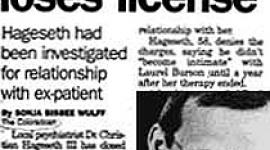Does Electroconvulsive Therapy Prevent Suicide?
Victor Milstein, Ph.D., Joyce G. Small, M.D., Iver F. Small, M.D., and Grace E. Green, B.A.
Larue D. Carter Memorial Hospital and Indiana University School of Medicine. Indianapolis, Indiana, USA.
Convulsive Therapy
2(1):3-6, 1986
 Summary: To examine the issue of whether or not electroconvulsive therapy (ECT) protects against suicidal death, we followed a complete population of 1,494 adult hospitalized psychiatric patients for 5-7 years. During that time there were 76 deaths of which 16 or 21% were by suicide. Cause of death was not significantly related to age. gender or research diagnosis. Patients who committed suicide were more apt to have received ECT than those who died from other causes, but this difference was not significant. A control group of living patients matched for age, sex, and diagnosis had very similar exposures to ECT. which further indicates that ECT does not influence long-term survival. These findings combined with a close examination of the literature do not support the commonly held belief that ECT exerts long-range protective effects against suicide.
Summary: To examine the issue of whether or not electroconvulsive therapy (ECT) protects against suicidal death, we followed a complete population of 1,494 adult hospitalized psychiatric patients for 5-7 years. During that time there were 76 deaths of which 16 or 21% were by suicide. Cause of death was not significantly related to age. gender or research diagnosis. Patients who committed suicide were more apt to have received ECT than those who died from other causes, but this difference was not significant. A control group of living patients matched for age, sex, and diagnosis had very similar exposures to ECT. which further indicates that ECT does not influence long-term survival. These findings combined with a close examination of the literature do not support the commonly held belief that ECT exerts long-range protective effects against suicide.
At the recent Consensus Development Conference on Electroconvulsive Therapy (ECT) sponsored by the National Institutes of Health and Mental Health, there was much argument concerning whether ECT does or does not reduce the risk of suicide. At first, this concern would appear to be superfluous as ECT is known to be an effective form of treatment for severe depression and other illnesses that are associated with a significantly elevated risk of suicide. The conference report (Consensus Development Conference, 1985) states that "the immediate risk of suicide (when not manageable by other means) is a clear indication for consideration of ECT." However, factual data in support of this contention are not readily obtainable.
Studies by Tsuang et al. (1979) and Avery and Winokur (1976) often are quoted as showing that ECT is associated with lower mortality rates than is drug therapy or institutional care in the treatment of patients with schizoaffective disorder or depression. However, their data show reduced mortality from all causes but no significant reduction in suicidal death per se. Avery and Winokur (1976) found that death from suicide was not different in patients receiving ECT compared with those receiving other treatment modalities. Later, these same authors (1978) demonstrated that patients who were treated with ECT made significantly fewer suicide attempts ova a 6-month follow-up period than did patients who did not receive ECT. However, Babigian and Guttmacher (1984) failed to demonstrate that ECT exerts a protective influence against suicidal death. Eastwood and Peacocke (1976) did not find an interrelationship between suicide, hospital admissions for depressive illness, and ECT.
Review of the early literature also reveals conflicting findings. Ziskind et al. (1945) reported that treatment with ECT or pentylenetetrazol (Metrazol) reduces death from suicide. Huston and Locher (1948a) found that none of their patients with involutional melancholia treated with ECT committed suicide, whereas 13% of untreated patients did. The same authors reported a lower rate of suicide in manic depressive patients treated with ECT than in untreated patients (1948b). However, two subsequent studies (Bond, 1954; Bond and Morris, 1954) found no significant protective effect of ECT against suicide in patients with either involutional psychosis or manic depressive illness.
FOLLOW-UP STUDIES
In an effort to cast light on this still unresolved question, we report our findings from follow-up studies of a series of 1,494 patients. They consisted of all consecutive adult admissions to Larue D. Carter Memorial Hospital during the years 1965-72. Further details concerning the facility and patient sample appear elsewhere (Small et al., 1984). From contacts with families and attending physicians and cross-referencing of patients' names listed on Indiana death certificates, we ascertained that 76 patients had died during the 5- to 7-year follow-up period. Thus, 5.1% of the total sample had died by the time of follow-up, and of these, 16 or 21% were the result of suicide. Causes of death were examined in relation to age, sex, retrospective research diagnosis (Feighner et al., 1972), and whether or not the patient had received ECT during the index hospitalization or at any time in the past. These data are summarized in Table 1.
Neither age nor gender was significantly related to suicidal versus nonsuicidal deaths. There were no significant associations with research diagnoses grouped in terms of affective disorder, schizophrenia, or other conditions. Forty-four percent of the patients who committed suicide had been treated with ECT during the index hospital admission, whereas 32% of patients who died from other causes had received ECT. These differences were not statistically significant.
In view of these negative findings, we next evalokated a control group of patients who were still alive at follow-up. The patients comprising this group were individually and exactly matched for sex and research diagnosis (Feighner et al., 1972) with those who had died. They also were matched for age as-closely as possible and for date of admission to the hospital. When we examined the ECT experience of these living matched control patients and compared them with those of the patients who had died, we found no statistically reliable differences (Table 1).
DISCUSSION AND CONCLUSION
The results of this retrospective study do not support the contention that ECT exerts long-term protective effects against suicide. Although not statistically significant, more of the patients whose death was ascribed to suicide had received ECT during their index hospital admission than those who died from other causes (44 vs. 32%). Similarly, when their previous ECT experience was added, more patients who died as a result of suicide had received ECT (50 vs. 40%). The matched control group revealed very similar percentages, suggesting that ECT has minimal impact on long-range survival. To consider the early studies demonstrating that ECT exerts a protective effect against suicidal death, the published data must be reworked to determine whether differences were significant. Ziskind et al. (1945) followed 200 patients for a mean of 40 months (range 6-69 months). Eighty-eight patients were treated with either Metrazol or ECT. The remaining 109 patients either refused convulsive therapy (n=43), had symptoms too mild to warrant this treatment (n=50), or had a condition contraindicating ECT (n=16). There were 13 deaths in the control patients with 9 by suicide, compared with 3 deaths with 1 suicide in the convulsive therapy patients. These data yield a Fisher's exact probability of 0.029, indicating a significant association between treatment/nontreatment and suicide/other causes of death. However, the conditions of the 16 patients with contraindications to ECT and whether they contributed disproportionately to the suicides are unknown.
Huston and Locher (1948a) compared patients with involutional psychosis untreated and treated with ECT. They found that none of the patients in the convulsive therapy group committed suicide, whereas 13% of those untreated did. Interpretation of this study is complicated by the fact that they followed the ECT-treated patients for a mean of 36 months (range 1-48 months) and the untreated patients for 77 months (range 2 days to 180 months). In a subsequent report on manic depressive psychosis treated with ECT or not, the same authors ( 1948b) found that the ECT-treated patients, followed for a mean of 36 months, had a 1% suicide rate, while the control patients, followed for a mean of 82 months, had a 7% suicide rate. Examining the association of ECT/no ECT and death from suicide/other causes yielded a nonsignificant probability using fisher's exact method. In studies of patients with involutional psychosis (Bond, 1954) and manic depressive illness (Bond and Morris, 1954) examined 5 years after treatment with ECT or no treatment, analysis of these data does not reveal a significant protective effect against suicide of ECT compared with nontreatment.
Thus, we are able to point to only one study, the very early report of Ziskind et al. (1945), which indicates a significant protective effect of ECT against suicide. The remainder of the evidence is overwhelmingly negative. It appears to us that the undeniable efficacy of ECT to dissipate depression and symptoms of suicidal thinking and behavior has generalized to the belief that it has long-range protective effects. In one sense, it is reassuring that this very effective somatic therapy does not exert long-reaching influences on future behavior, in another, it is disappointing that it does not.
Acknowledgment: This work was supported in part by a grant from the Association for the Advancement of Mental Health Research and Education. Inc., Indianapolis. IN 46202. U.S.A.
next: ECT and Non-Memory Cognition:
~ depression library articles
~ all articles on depression
REFERENCES
Avery, D. and Winokur, G. Mortality in depressed patients treated with electroconvulsive therapy and antidepressants. Arch. Gen. Psychiatry: 33:1029-1037. 1976.
Avery, D. and Winokur, G. Suicide, attempted suicide, and relapse rates in depression. Arch. Gen. Psychiatry. 35:749-7S3, 1978.
Babigian H. M., and Guttmacher, L. B. Epidemiologic considerations in electroconvulsive therapy. Arch. Gen. Psychiatry. 41:246-2S3. 1984.
Bond, E. D. Results of treatment in psychoses with a control series. II. Involutional psychotic reaction. Am. J Psychiatry. 110:881-885. 1954.
Bond, E. D. and Morris, H. H. Results of treatment in psychoses with a control series. III. Manic depressive reactions. Am. J Psychiatry: 110:885-887. 1954.
Consensus Conference. Electroconvulsive therapy. JAMA. 254:2103-2108,1985.
Eastwood, M.R. and Peacocke. J Seasonal patterns of suicide, depression and electroconvulsive therapy. Br. J. Psychiatry. 129:472-47S. 1976.
Feighner, J. P.. Robins, E.R., Guze, S. B.. Woodruff. R. A. Jr.. Winokur, G. and Munoz, R. Diagnostic criteria for use in psychiatric research. Arch. Gen. Psychiatry: 26 57-63, 1972.
Huston, P.E. and Lecher, L. M. Involutional psychosis. Course when untreated and when treated with electric shock. Arch. Neurol. Psychiatry. 59:385-394, 1948a.
Huston. P. E. and Locher. L. W. Manic-depressive psychosis. Course when treated and untreated with electric shock. Arch. Neurol. Psychiatry: 60:37-48, 1948b.
Small, J G., Milstein, V., Sharpley; P. H., Klapper. M. and Small, J. F. Electroencephalographic findings in relation to diagnostic constructs in psychiatry. Biol. Psychiatry: 19:471-478, 1984.
Tsuang, M. T., Dempsey, G. M. and Fleming, J A. Can ECT prevent premature death and suicide in schizoaffective patients? J. Affect.. Disorders. 1:167-171, 1979.
Ziskind, E., Somerfeld-Ziskind, E. and Ziskind, L. Metrazol and electric convulsive therapy of the affective psychoses. Arch. Neurol. Psychiatry. 53:212-217.1945.
next: ECT and Non-Memory Cognition:
~ all Shocked! ECT articles
~ depression library articles
~ all articles on depression
APA Reference
Staff, H.
(2007, February 19). Does Electroconvulsive Therapy Prevent Suicide?, HealthyPlace. Retrieved
on 2025, November 29 from https://www.healthyplace.com/depression/articles/does-electroconvulsive-therapy-prevent-suicide



